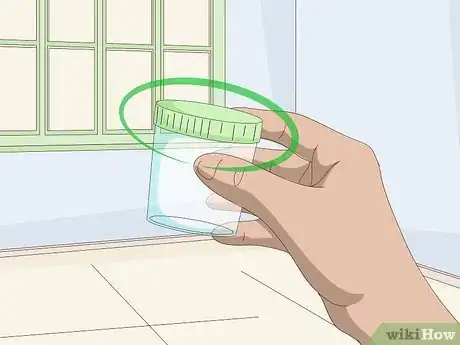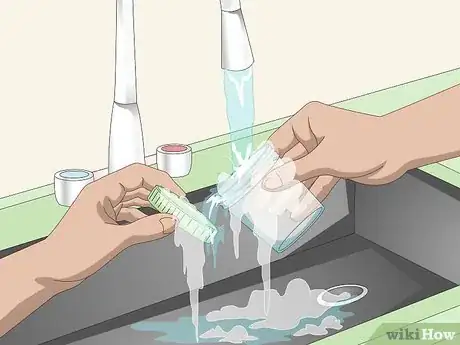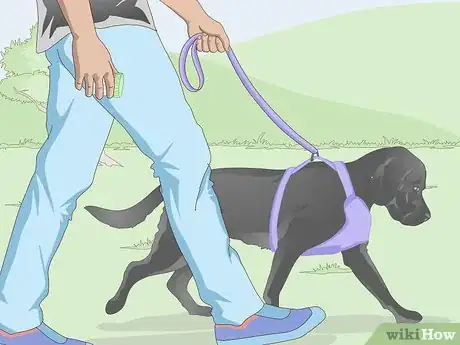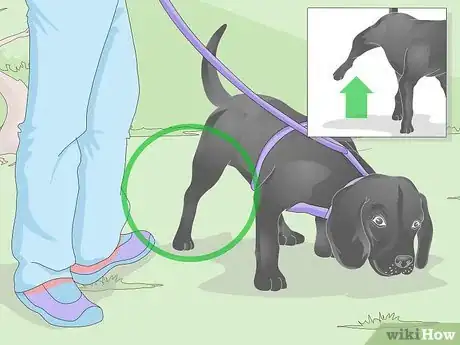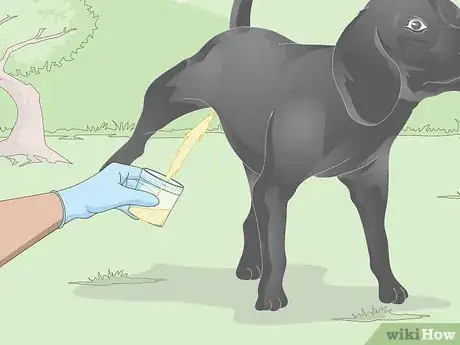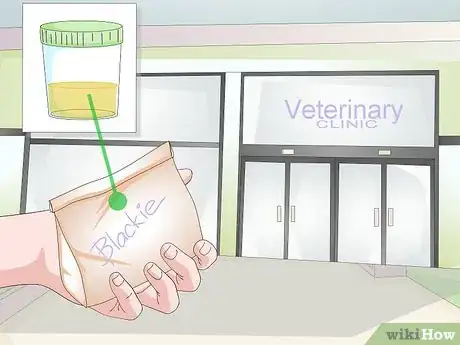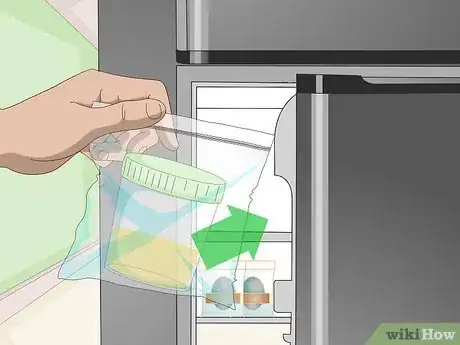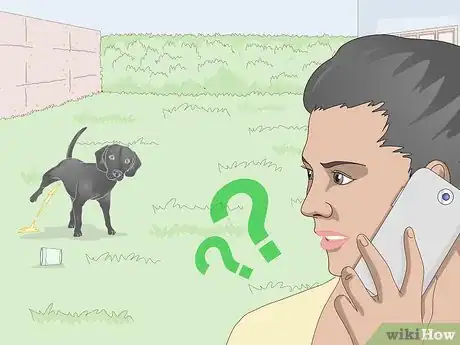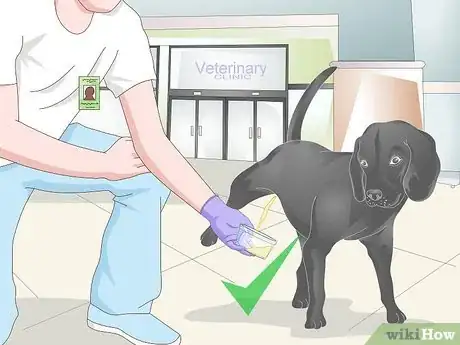This article was co-authored by Pippa Elliott, MRCVS. Dr. Elliott, BVMS, MRCVS is a veterinarian with over 30 years of experience in veterinary surgery and companion animal practice. She graduated from the University of Glasgow in 1987 with a degree in veterinary medicine and surgery. She has worked at the same animal clinic in her hometown for over 20 years.
This article has been viewed 46,940 times.
A urine sample can provide your vet with useful information about your male dog’s health. For example, a urinalysis can let your vet know if your dog has a urinary tract infection, diabetes, or kidney disease.[1] If your vet asks for a urine sample from your male dog, collect the sample as soon as you can and take it to your vet. Fortunately, collecting the sample doesn't need to be stressful or challenging. With patience and preparation, you can properly collect and handle the sample.
Steps
Getting the Urine Sample
-
1Decide when to get the sample. Your male dog may not be thrilled about you collecting its urine. To make the process a little easier for the both of you, get the urine sample when you know your dog’s bladder is going to be full, such as first thing in the morning or when you get home from work.[2]
- A urine sample collected first thing in the morning is usually the most accurate.
- You can also try collecting a sample after a meal, or on your normal walk when there are interesting smells to sniff and your dog wants to mark its territory.
-
2Select a leak-proof container. Your vet may give you a small plastic container to collect your male dog’s urine.[3] If not, choose a plastic, leak-proof container that you have at home. Container options include:Advertisement
-
3Clean the container. To prevent dust or leftover food from contaminating your male dog’s urine, wash the container with hot, soapy water. Allow the container to dry completely before using it to get the urine sample.
-
4Walk your dog on a leash. Once you’re outside, your male dog may become suspicious and try to get away if it sees the container in your hand. To prevent your dog from getting away, put it on a leash when going outside. Preferably, use a non-retractable leash.[6]
- If you have a backyard, walk your dog to where it usually urinates. Your dog’s scent will already be there, so it will know that’s where it should urinate.
-
5Watch your dog closely. Depending on how full your dog’s bladder is, your dog may want to urinate almost as soon as it gets outside. Pay close attention to your dog so you can be ready to collect the urine when your dog lifts its leg.
- If it looks like your dog is going to lift its right back leg, stand on your dog’s right. If you think your dog will lift its left back leg, stand on the left side.
- Stand slightly to the back of your dog.
-
6Catch your dog’s urine in the container. When your dog lifts its leg, gently and swiftly place the container in the urine stream.[7] Do not make sudden movements, or you may alarm your dog. Move the container away once your dog finishes urinating.
- You may get a little urine on your hand that’s holding the container. If you don’t want to get urine on your hand, consider wearing a rubber glove.
- To keep your hand from getting urine on it, you could also make a handle by taping a ruler to the outside of the container.[8]
Handling the Sample
-
1Seal the container. When you have collected the urine, you will need to cover the container so the urine doesn’t spill out or get contaminated.[9] The best seal will be the lid that goes with the container. If you do not have the matching lid, tightly cover the container with a few layers of plastic wrap.
- If you use plastic wrap to cover the container, keep the plastic wrap in place with a rubber band.
- If any urine got on the side of the container, wipe it off with a dry paper towel.
- Wash your hands with warm, soapy water before and after sealing the container.
-
2Take the sample to your vet’s office. A urinalysis will be most accurate when the urine sample is fresh (collected no more than a few hours beforehand). After the container with the urine sample is securely sealed, place it in a bag and put your dog’s name on the bag. Then, take the container to your vet’s office.
-
3Store the urine sample at home. If you can’t drop off the urine sample soon after collecting it, you will need to keep it cool until you have time to drive to your vet’s office. Options for cool storage of urine are a refrigerator or a cooler with ice.[10]
- If you choose to store the urine sample in your fridge, place the container with the sample in a plastic bag to prevent any urine from contaminating the fridge.
- Storing your dog’s urine in your fridge may make you uncomfortable. If so, store the sample in a cooler.
- Do not store the urine for more than 12 hours. After 12 hours, the urine sample will no longer be fresh enough to use for a urinalysis.
Getting Help
-
1Have someone help you. You might have an easier time getting the urine sample from your male dog if you have some help.[11] Ask a friend or family member to either walk your dog or position the container in the urine stream.
-
2Contact your vet. If you’re not able to get a urine sample, don’t worry. Simply contact your vet and let them know. They can give you extra guidance or suggest having their staff collect the sample for you.
-
3Allow the vet’s staff to collect the sample. If you choose to have the urine sample collected at the vet's office, one of the staff members will take your male dog outside to get a sample when you arrive. If that’s unsuccessful, the staff may use another method, called cystocentesis, to collect some urine.
- To perform a cystocentesis, several staff members will place your dog on its back while another staff member carefully inserts a clean needle directly into your dog’s bladder and draws up the urine.[12]
Warnings
- Some dogs may stop urinating as soon as they know someone is trying to collect their urine.⧼thumbs_response⧽
Things You'll Need
- Leash
- Shallow, waterproof container
- Rubber or plastic gloves (optional)
References
- ↑ http://www.clarkanimalcare.com/for-owners-clients/educational-handouts/collecting-urine/
- ↑ http://www.clarkanimalcare.com/for-owners-clients/educational-handouts/collecting-urine/
- ↑ http://www.preventivevet.com/dogs/going-to-the-vet-how-to-collect-your-dogs-urine-sample
- ↑ http://vavetderm.com/for-patients/first-visit-at-veterinary-dermatology-of-richmond/
- ↑ http://www.holisticvetcenter.com/urine-sample.htm
- ↑ http://www.preventivevet.com/dogs/going-to-the-vet-how-to-collect-your-dogs-urine-sample
- ↑ http://www.clarkanimalcare.com/for-owners-clients/educational-handouts/collecting-urine/
- ↑ http://vavetderm.com/for-patients/first-visit-at-veterinary-dermatology-of-richmond/
- ↑ http://www.preventivevet.com/dogs/going-to-the-vet-how-to-collect-your-dogs-urine-sample
- ↑ http://www.preventivevet.com/dogs/going-to-the-vet-how-to-collect-your-dogs-urine-sample
- ↑ http://www.preventivevet.com/dogs/going-to-the-vet-how-to-collect-your-dogs-urine-sample
- ↑ http://www.vcahospitals.com/main/pet-health-information/article/animal-health/urinalysis/406
- ↑ http://www.vcahospitals.com/main/pet-health-information/article/animal-health/urinalysis/406
About This Article
To get a urine sample from a male dog, plan to collect it first thing in the morning or when you get home from work when you know its bladder is full. Next, clean out a plastic, leak-proof container to catch the urine in. Then, take your dog on a walk and watch for it to lift its leg to urinate. When it does, position the container in the urine stream, catch the urine in the container, and seal the container tightly. For tips on properly storing a urine sample, read on!

